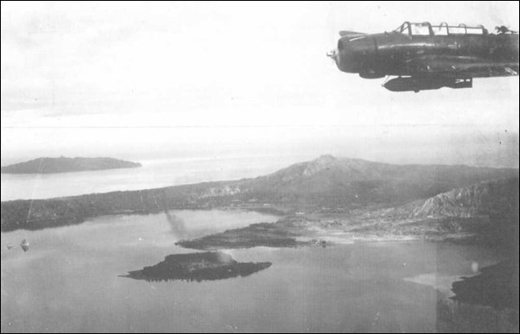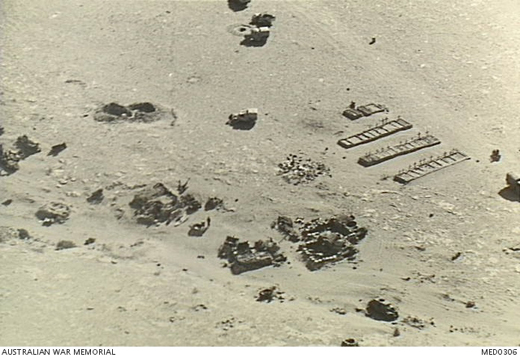Air Operations, CBI
3 Japanese Ki-27 'Nate' fighters are shot down over the Mesoht Airdrome in Thailand by 2nd AVG Fighter Squadron P-40s.
[Air Operations, Europe
BOMBER COMMAND20 Wellingtons and 5 Hampdens raid Emden. 3 Wellingtons and 1 Hampden are lost.
[Air Operations, Far East
Japanese planes bomb Singapore city killing 50 people and injuring another 150.
[Bismarck Archipelago
Carrier-borne Japanese bombers attack Rabaul, New Britain, causing serious damage to airport installations. There is also a minor attack on Kavieng in New Ireland.
A B5N2 'Kate' from the Carrier Akagi |
 |
Burma
Japanese forces from Thailand penetrate in large numbers into Burma. The main attack in the region of northern Tenasserim demolishes the 17th Indian Div and a single Burmese division both commanded by Lt-Gen T. J. Hutton attempting to defend the town of Moulmein.
[Eastern Front
Following up their counterattack in the central sector, the Russians retake Mozhaysk about sixty miles west of Moscow. The Russians recapture Toropetz, northeast of Velikie Luki.
NORTHERN SECTORThe German hold on Staraya Russa is helped by counterattacks by the 11th Army mounted by the German SS Totenkopf and 18th Motorized Divs. Farther south, the Soviet 4th Shock Army recaptures Totopets together with much ammunition and other supplies.
CENTRAL SECTORThe German 4th Army is forced out of Mozhaisk, prompting Hitler to replace its commander, Kubler, with Heinrici.[MORE]
[Germany, Policy
During the Wannsee Conference in Berlin, Heydrich outlines Hitler's plans for the 'Final Solution' of the Jewish 'Problem'. Meeting, ironically, in the Berlin suburb office of the International Criminal Police Commission, the SS, police, and officials of other Axis nations are told that all European and British Jews will be sent to work projects and many 'will fall out through natural diminution.' He then added, 'The remnant that is able finally to survive all this, since this unquestionably is the part with the strongest resistance, must be given treatment accordingly, because these people, representing a natural selection, are to be regarded as the germ-cell of a new Jewish development should they be allowed to go free.' It is cryptic, but clear. Genocide will become the order of the day.
Reinhard Heydrich hosts a conference of Nazi Party and government officials in the SS RHSA headquarters at Wannsee, a Berlin suburb. The meeting is chaired by Heydrich and attended by 15 SS and government officials, including Stukart, Heinrich Müller, Adolf Eichmann, head of the 'Jewish Evacuation Department' of the Gestapo, and Freisler.
In July 1941, Heydrich had been appointed the officer in charge of planning the 'Final Solution' of the Jewish 'problem'. In the early years of the Nazi regime, they promoted the idea of achieving Aryan racial purity. They decided that undesirables - Slavs, Gypsies, homosexuals, and the handicapped and mentally ill - were to be disposed of. But the chief target of the regime's campaign was the Jewish population of Germany; later, of all Europe. A policy of consistent persecution was followed during the 1930s, but a more ambitious program was crafted under the cover of the war. Hitler announced that about 11 million European Jews yet remained to be dealt with. He had decided that a 'Final Solution' to the Jewish problem must be implemented while the war was going on.
The Wannsee Conference, as it was known, lasted only a few hours, and proposed the 'Final Solution'. The idea of mass deportation was ruled out as impractical, considering the ongoing war. Forced sterilization was discussed, but no decision was made at the conference. But as a result of it, directives were sent to move Jews to the East as part of the 'territorial solution'. No doubt was left that this meant the physical destruction of all Jews, accelerating the process that had already started. The Einsatzgruppen had already been in action for six months and the first extermination camp, at Chelmno, was by then in operation. The conference decided that the best policy was to round up the Jews from all parts of Europe and send them eastward to work in labor gangs. Hard enough work, it was believed, would result in significant loss of life. Within a few weeks the first poison gas chambers in concentration camps were build in Poland. Responsibility for carrying out the policy of extermination was given to Reichsführer-SS Heinrich Himmler. The conference gave Eichmann the necessary authority for his actions in the various ministries, and 30 copies of the conference records were distributed to them. At no point was killing mentioned. Recipients were expected to understand the meaning of 'final solution' and 'deportation to the East'. The policy of extermination went forward until the end of the war. Accurate numbers are impossible to obtain, but the estimates run as high as 15 million people, including 6 million Jews. They were liquidated in the camps or by mass executions in isolated places.
[ Knocked Out Tanks, Armored Vehicles and Emplacements |
 |
Indian Ocean
I-59 sinks the Norwegian steamer Eidsvold (4184t) anchored off Christmas Island. The entire crew are rescued by the British light cruiser Durban.
[Japan, Policy
Japanese Prime Minister Hideki Tojo issues a warning to Australia that, 'if you continue your resistance, we Japanese will show you no mercy.'
[Malaya
There is a counterattack by the British 53rd Brigade west of Yong Peng, but with no success. The forces cut off in the Muar area try to break out but they are held. Withdrawal of Segamat forces continues. During the night, the Australian 27th Brigade Group moves from the Segamat River line to Yong Peng. The Indian 9th Division pulls back to a defensive position to the east.
[Pacific
- 2 Japanese submarines shell Midway Island.
- The Japanese minelaying submarine I-124 is sunk in the Timor Sea off Port Darwin by the US destroyer Edsall (DD-219) and 3 Australian corvettes, Deloraine, Katoomba and Lithgow.
- 'China Force' is formed to escort Allied convoys between Singapore and the East Indies. The force initially consists of 3 cruisers, 6 destroyers and 2 sloops.
- The Norwegian steamer Herstein (5100t) is sunk by Japanese bombing at Rabaul with the loss of 1 of her crew.
Philippines
On Luzon the Japanese contain repeated attacks by the Philippine Division (US 31st and PS 45th Regiments) on the western flank of the II Corps while preparing for a major assault to begin on the 22nd. After further fighting beforw Guitol, the Japanese retire northward. In the I Corps area, the Japanese maintain pressure and continue infiltration in the right flank from Mt Silanganan.
[Occupied Europe
At a conference held in Berlin, which will become known as the Wannsee Conference, Heydrich presents plans to Hitler for the 'Final Solution' to the 'Jewish Problem'. These plans provide for the transportation of all Europe's Jews to extermination camps. Hitler gives his approval. Eichmann will be in charge of the department of the SS responsible for the execution of the plan (see March 1942).
[